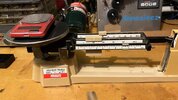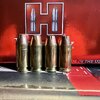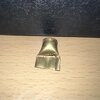9mmGoon
Member
- Joined
- Nov 29, 2023
- Messages
- 76
To those, including myself, who questioned the accuracy of my scale, i can undoubtedly say it is spot on. I received my brand new Ohaus triple beam scale today and confirmed the accuracy of my little hornady digital scale with dang near every object i could weigh with it. Including powder charges.
It was suggested to pull bullets and verify charge weights. Of 200 pulled i found no greater than .2 grains of difference.
200 bullets weighed found no greater than .7 grains of difference. Go Hornady!
Testing set back. This will be interesting.
Some of you know i loaded 50 in brand new Remington brass as well as 50 in range brass “terrifying” and today i shot the Remington with no failures. What about the range brass?
Here’s the interesting part. Of the 200 i pulled i ran 45 of them through the gun racking the slide. I measured each one before and after. 31 did not move. 14 set back 2 thousandths or less. This prompted me to test the newly assembled Remington and range brass loads.
Remington performed flawlessly, the range brass was a different result. Perhaps i shoulve separated and loaded them in batches according to headstamp because i had some serious set back in those that felt softer than others. Of the softer feeling brass, the setback was unimaginable from 10 to 25 thousandths. I was particularly surprised to find two of them were Hornady…what? Absolutely . I immediately snatched the defensive rounds out of my magazine and started looking. Sure enough! I found 2 with considerable setback in that magazine. Probably due to being racked and unloaded. So then i tested two more by simply pushing down on them and i was able to nearly bury the bullet. Shocking.
. I immediately snatched the defensive rounds out of my magazine and started looking. Sure enough! I found 2 with considerable setback in that magazine. Probably due to being racked and unloaded. So then i tested two more by simply pushing down on them and i was able to nearly bury the bullet. Shocking.
So after all that pain of bullet pulling and powder dumping and weighing this, and weighing that, i still have no answer if its the old brass causing the failures. It could be, yes, but it could also be setback. As i have learned it appears it can happen if i set my bell die to a particular case of a particular length and hardness and If perhaps a softer case comes along it could get an excessive amount of bell thus making it prone to setback. Or perhaps the case i set my bell with had a little more spring back than others and i over belled some of them as a result. I will just have to test the rest of my loads with the “mash on it test” and see if i can find a squishy one.
I tell you this though, i haven’t found a single one of mine as squishy as these factory Hornady defense rounds.
For me, its still up in the air until i find the smoking bullet, per say.
It was suggested to pull bullets and verify charge weights. Of 200 pulled i found no greater than .2 grains of difference.
200 bullets weighed found no greater than .7 grains of difference. Go Hornady!
Testing set back. This will be interesting.
Some of you know i loaded 50 in brand new Remington brass as well as 50 in range brass “terrifying” and today i shot the Remington with no failures. What about the range brass?
Here’s the interesting part. Of the 200 i pulled i ran 45 of them through the gun racking the slide. I measured each one before and after. 31 did not move. 14 set back 2 thousandths or less. This prompted me to test the newly assembled Remington and range brass loads.
Remington performed flawlessly, the range brass was a different result. Perhaps i shoulve separated and loaded them in batches according to headstamp because i had some serious set back in those that felt softer than others. Of the softer feeling brass, the setback was unimaginable from 10 to 25 thousandths. I was particularly surprised to find two of them were Hornady…what? Absolutely
So after all that pain of bullet pulling and powder dumping and weighing this, and weighing that, i still have no answer if its the old brass causing the failures. It could be, yes, but it could also be setback. As i have learned it appears it can happen if i set my bell die to a particular case of a particular length and hardness and If perhaps a softer case comes along it could get an excessive amount of bell thus making it prone to setback. Or perhaps the case i set my bell with had a little more spring back than others and i over belled some of them as a result. I will just have to test the rest of my loads with the “mash on it test” and see if i can find a squishy one.
I tell you this though, i haven’t found a single one of mine as squishy as these factory Hornady defense rounds.
For me, its still up in the air until i find the smoking bullet, per say.




